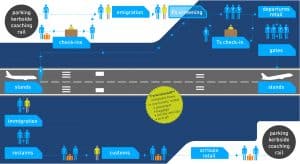
The movement of passengers through airport has always been of the utmost importance to AiQ Consulting and our clients. Whether it is realising capacity , improving check in processes and developing hold baggage systems, the flow of passengers is always critical.
And why shouldn’t it be? Without passengers, there would be no airport, and their wants and needs shape the way airports are constructed and managed. When we provide simulations to recreate a problem or offer solutions for clients, the data we use conveys typical human behaviour in all passengers.
This is very important when looking in detail about airport passenger flows. People can stop and start in their journey for no reason, but more often than not we can track and convey their quirks with our bespoke software. Visiting retail to grab last minute items, a toilet break, using charging points before a long haul flight… all of these essential but often ignored points in their journey or ‘flow’ through the airport need to be considered when recreating the terminal. We refer to this typical human behaviour as ‘full human physics behaviour’.
The different types of passenger also have an impact. Passengers with Restricted Mobility (PRMs) need a different level of support, from PRM buggies to lifts, and this must be fulfilled by airports. It isn’t only a legal requirement that they do so, but it is also a necessity to ensure that passenger flows keep moving throughout the airport.
For example, one of our recent projects at London Gatwick looked at producing a simulation to quantify the benefit of constructing two PRM lifts. This was for the airport’s Interterminal Transit System, connecting their North and South terminals, which also has a further main Rail network station connection and a bus station underneath. The simulation we created followed designated individual passengers from the concourse and showed the design flows, objectives and outcomes, looking in detail at this ‘full human physics behaviour’ in both ‘typical’ passengers and PRMs.
With an average of 150 people on each train, ready to navigate leaving the train and getting into the terminal with their baggage, as well as wishing to board the train after their arrival at Gatwick, it was important to clarify that PRM volumes and the use of the proposed lifts would not interfere with the terminal design and the passenger flows in a negative way.
Using our bespoke modeling tool, TransvisionAiR™ and our 3D simulation experience, we were able to project the amount of space and access required to service two new lifts for PRM access from the bus station below. Our simulations gave the client, stakeholders and designers the confidence that the two PRM access lifts were the only alterations needed to cope with the flow in the Interterminal Transit System. It would enhance the passenger flow in the transit system, as well in and out of the terminals.
Being able to define and replicate the passenger flow before any investment in structural changes is of great benefit to our clients and stakeholders – as well as being extremely cost effective.
To find out more about airport passenger flows, contact us today

